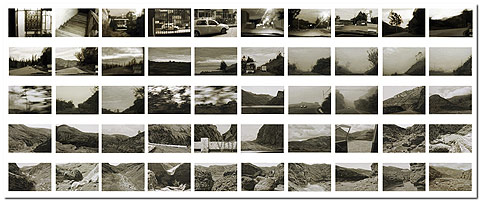DPM Gallery,
Nov 11, 2006 - Dec 11, 2006
Guayaquil-Miami, Ecuador
Travelling Instructions*
by Cristóbal Zapata
If Coordenadas goes from nature to culture, from landscape to its ghost, Sábanas travels the opposite road, going from ghost to landscape, for a manufactured length of textile, with folds and shirrs raises in the spectator countless orographic and topographical associations with themes as diverse as they are opposed: waves, dunes, deserts, steppes, savannahs. Facing the unfolding of nature, from the intimacy of the bed, Cardoso draws a fold that evokes it and becomes its ontological self.
And the genealogy of that fold, according to what Deleuze has said, is in the baroque, whose characteristic "is the fold unto infinity", acting "according to two directions, to two infinities, as if the infinite had two floors: the folds of the material and the folds in the soul".(4) We recall the careful work in monks' habits in Zurbarán, or the exacerbation of the curves and twists in the tunic of Bernini's Saint Therese. Cardoso's bed sheets - shrouds, profane linens - fold in the morbid and sumptuous sensuality, they inherit the tension and twists which pierce the spirit of the baroque, just as the programmed staged lighting which directs painting, sculpture and architecture of that period. It is precisely to accentuate this dramatic effect that these sheets were photographed with backlighting -equivalent to the baroque chiaroscuro and penumbra -, conferring to the paintings on one hand that vespertine atmosphere, and on the other, outlining the contours, their sculptural volume. And it is also in the imaginary context, or in the style of the Baroque pathos, where the invertebrates that travel over the sheets acquire a first meaning, as moral allegory or vanitas, as metaphors of decrepitude and death; the topic of the memento mori where Cardoso’s work goes over and over again. The bed sheets, of course, can also become shrouds.
3. Road pictures
One of Cardoso’s most recent works, done this year, is the trilogy Abismo-Desierto-Mar ("Abyss-Desert-Sea", 2006), voyages which depart from his house to three nearby points in whose trajectories the landscapes change little by little until they change drastically. Certain paintings remind us of the steep and desolate landscapes of romantic painting, particularly some of the cliffs and seascapes of Caspar David Friedrich. This is not coincidental: the romantic artist is the first to experience the profound excision between man and nature, a breech which in the modern period will augment to the point of expelling nature from its imagery. While the romantic painter projects his subjective mood into a painting of mountains or a sunset, in Cardoso, on the contrary, it is the infinity of these spaces that waken a sense of the finite, of our emptiness and essential precariousness. These spaces where nothing happens, or nothing seems to occur, become places appropriate for metaphysical revelation. In these landscapes of otherness, we have dialogues with the other: emptiness, death.
It is possible to establish an analogy between this trilogy and the cinematographic genre of the road-movie, films filled with narrative events, where the characters live a series of adventures. In contrast, in Cardoso’s road-pictures -to invent a neologism - all the adventures are internal: they are the tribulations of a vision which is fascinated with the mutations of the landscape, with the transformations of atmosphere and climate, but also the reflections on the uninterrupted flow of life.
At this time the artistic itinerary of Cardoso ends with the series FF (nomenclature of "fast forward", the option on the remote control for video equipment to advance the sequences). The work at this point consists of four sequences (of eight frames each) that correspond to four different characters. What we see are figures running, out of focus, and as such not recognizable, anonymous. Not only is each frame treated like a photogram, but also it is placed in perpendicular form which reminds us of movie cameras where the film passes vertically. We could say that these works deal with the voyages series in that they are derivative, but different in that they do not presuppose the idea of moving from one point to another; the actors go from whatever point to any other, or to none at all.
Each runner bears a story and appears to find himself in a dire situation. Thus the deliberate use of low angle shots, recurring planes used in expressionist cinema to accentuate drama, tension and suspense in the scene. Photographing his characters in the act of running the artist activates in the spectator multiple interrogatories: who, why, what for, to where, underlining the mystery and narrative dimension of his proposal. Beyond what these runners may signify (the fugacity of time, the speed of contemporary life), Cardoso again stretches the boundaries between document and fiction.
With this last cycle, Cardoso closes a circle of extraordinary coherence: from still life to film-still, from still life to photogram. In terms of time, his work has gone from time immobilized in the instant "the fundamental of still life", to time in movement of cinema. Two manners diametrically opposed of visualizing and experiencing time, of understanding and comprehending it; but also of grasping and capturing it: the great inducements of his indefatigable voyage.
Cuenca, August 18, 2006.
-Cristóbal Zapata
Curator, art critic, film critic and poet. He lives and works in Cuenca, Ecuador.
Bibliography:
(1) Owens, Craig, "El impulso alegórico: contribuciones a una teoría de la posmodernidad", in Arte después de la Modernidad. Nuevos planteamientos en torno a la representación, Brian Wallis Ed., Madrid, Akal, 2001, p. 207.
(2) Chesterton, G.K., "Robert Browning", in Obras Completas, Plaza y Janés, Barcelona, 1962, p.137.
(3) D’Ors, Eugenio, Lo Barroco, Tecnos, Madrid 1993, p.29.
(4) Deleuze, Pilles, El pliegue. Leibniz y el Barroco, Paidós, Barcelona, 1989, p.11.
*Essay published in the exhibition catalogue. Courtesy of Pablo Cardoso and dpm gallery.
Link: dpm gallery
|











